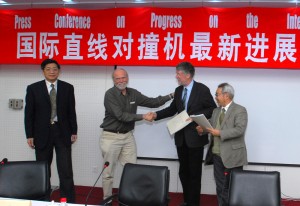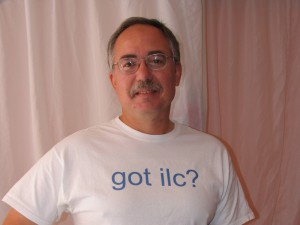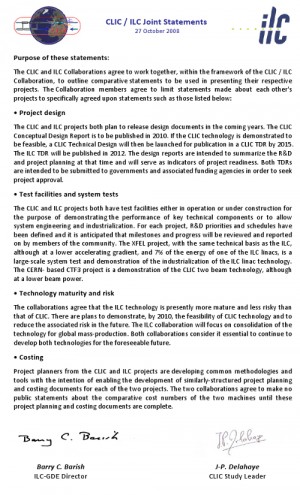Some T-shirts lose their lives in the wash, but their memories live on. At a meeting in Snowmass, US, in August 2005, Norman Graf was seen wearing a simple white t-shirt asking “got ilc?” (Not yet, Norm) And Nick Walker sported a yellow shirt that said “Summer In Snowmass – Some Are Not.”). Those who were witnessed the birth of the Global Design Effort or GDE, the team (counting precisely 49 members at the time) that took several existing plans for future accelerators and a decision on its technology) and turned them into one sound, streamlined and strawman-baselined design for the International Linear Collider. With the completion of Technical Design Report (TDR) the GDE has ticked its final to-do box, and when the final TDR is handed over to the International Committee for Future Accelerators (ICFA) in June, there will be no more GDE.
The Global Design Effort would never have come into existence, however, had there not been a panel, devised by ICFA, to decide which acceleration technology should be used for the next-generation collider. It was a big decision between the so-called cold technology, based on superconducting radiofrequency, and warm X-band technology. Each technology had its own advantages, and for each of them, teams of talented and dedicated scientists and engineers had spent many years of R&D. But planning of the next-generation machine had reached a stage at which it would have been too costly and time-consuming to develop both technologies towards construction. A decision was needed, and a panel to take this decision. The chair? Barry Barish.
“It is hard to recall how many meetings Barry and I have attended together trying to move the cause of the ILC forward,” recalls former DESY Director and ICFA chair Albrecht Wagner. “I first met him well before the GDE, the ILC Steering Committee (ILCSC), ICFA and before Barry took the helm of the GDE, during a meeting at Snowmass where I was given by him a cross examination on the TESLA project. Barry always impressed me by his calm, attentive way to listen, to speak, and to ask pertinent questions. He has his own skillful way of bringing divergent ideas together, such that everybody could subscribe to the result. This was especially true when he led the International Technology Recommendation Panel. It had the difficult, yet very clear goal to recommend one and only one technology. He and his group mastered this challenge brilliantly, such that all who were concerned accepted the ‘verdict’, especially those who for many years had put tremendous effort into advancing the technology which finally was not recommended.
The moment of the announcement of this ‘verdict’ is burnt deeply into my memory. Barry had promised the three lab directors mostly concerned, Jonathan Dorfan, Yoji Tostsuka and me, to inform them of the recommendation one day before the public announcement at the 2004 ICHEP conference in Beijing. He told me he would call at 7:00 am. I was wide awake much before that time and nervously running around in my hotel room. At 7:00 sharp the phone rang, it was Barry. And in his calm voice he said: ‘To cut a long story short: It’s cold’. What he said afterwards was lost in emotions.”
Won Namkung from PAL, POSTECH, Korea, who used to be a member of the ILCSC and chaired the ALCSC as well, also has strong and fond memories of the ITRP process: “Barry has a strong magnetic field attracting everyone’s mind. Wearing blue jeans with grey hair, he looks like an old grandpa, but his leadership at ITRP was beyond anybody’s expectation, quickly reaching a consensus on a superconducting acceleration technology for ILC. I hosted the last meeting of ITRP in 2004 in Pohang, Korea. For RDR and TDR tasks, his accomplishments mark great milestones for the future of high-energy physics research. We are all in debt for his remarkable and excellent accomplishments, and we will remember him for a long time.
So the next step – the formation of the GDE and the nomination of Barry as its leader – seemed only natural. On 8 June 2005, Barry wrote his first Director’s Corner for ILC NewsLine, the first of roughly a Corner a week over a period of almost eight years. Surveys say that his Corners are the most read story in the newsletter, and they are known to trigger quite a number of discussions!

Barry Barish handing over the Reference Design Report to ICFA (Albrecht Wagner) and ILCSC (Shin-ichi Kurokawa), with Hesheng Chen looking on. Image: IHEP
Corner writing notwithstanding, Barry and his team, which he managed to make larger by the month, cracked on and less than two years after its formation the GDE published the Reference Design Report for the ILC, the blueprint and first detailed technical description of the future machine. It also gave the very first cost estimate for the ILC, in ILC units, which raised a lot of attention, not always of the wanted kind.
But what is an accelerator without its detectors? Even if the originally foreseen two interaction points were reduced to one for cost-cutting reasons, several detector concepts were vying for their space in the electron-positron collisions. The mainly Japanese and the mainly European, but otherwise very similar “Large Detector Concept” and “Global Large Detector” decided to merge to form the “International Large Detector” in 2007, and together with the Silicon Detector (SiD) and the “4th concept” detector they submitted Letters of Intent (LOIs) that needed validation through the detector review panel. ILD and SiD made it through and invented a number of new concepts along the way – push-pull, moving detectors on platform, power pulsing, high-granularity particle flow, you name it. The ILC’s Research Director Sakue Yamada put all concepts, letters, ideas and R&D efforts through their paces. And François Richard, former co-chair of the Worldwide Study and regional detector contact for Europe, recalls an episode with Barry: “At DESY at LCWS2007 I had the pleasure to present in the tent the future organisation of detectors in view of the LOIs. I remember, after the public discussion, asking Barry whether he would accept to chair our organisation. He politely declined, saying that our organisations were too complex to be handled… It was said in a quiet tone but leaving no room for further arguments.”
Times weren’t always rosy for the researchers and developers of the ILC, the next revolution in particle physics. December 2007 has gone down in the history of the GDE as Black December. US federal budget for fiscal year 2008 eliminated $90 million in funding for high-energy physics in the US. Included in the budget cuts was funding for US R&D on the International Linear Collider as well as on superconducting radiofrequency technology. In the UK, particle physicists and astronomers also faced a 25% cut in research spending.
With crucial projects and, more importantly, people, suddenly withdrawn, the remaining team had to make some tough decisions. Individual R&D projects were put into different priority categories, they were globally reorganised, and due to some creative accounting the odd key scientist who would otherwise have had to join other groups could be kept on the project. The fact that physicists are driven by determination and conviction helped the ILC through these tough times, but the mood was low. Efforts to lower the price tag of the machine became even more important than before.
It was also clear that potential future funders of a linear collider wanted to see collaboration between the friendly competitors CLIC and ILC. There are many common points and challenges to the two projects, so in November 2008, the ILC-CLIC collaboration was formalised by a joint statement of GDE Director Barry Barish and the CLIC study leader, Jean-Pierre Delahaye at the time. Leading CLIC scientists became part of the Executive Board, and in return the ILC sent representatives to the CLIC Collaboration Board, working groups were formed and the two projects became a happy particle physics patchwork family.
There will always be reports, and the two most important ones along the way to the ILC Technical Design Report was the Strawman Baseline Proposal, published in 2009, and the Interim Report, published in 2011.
Then something not completely unexpected but nevertheless overwhelming happened in 2012. On 4 July, CERN announced the discovery of a Higgs-like boson at the Large Hadron Collider, and with this, things really picked up. Proposals for a three-stage ILC including a Higgs factory started to make the rounds, and messages from Japan, whose particle physics community had already voiced great support for building the ILC there, are becoming increasingly official. So when will the ILC community be wearing t-shirts that can answer the ‘got ilc?’ question with a “yes!” printed on the back…?
Memories, and thank-you messages to Barry Barish and Sakue Yamada




Recent Comments